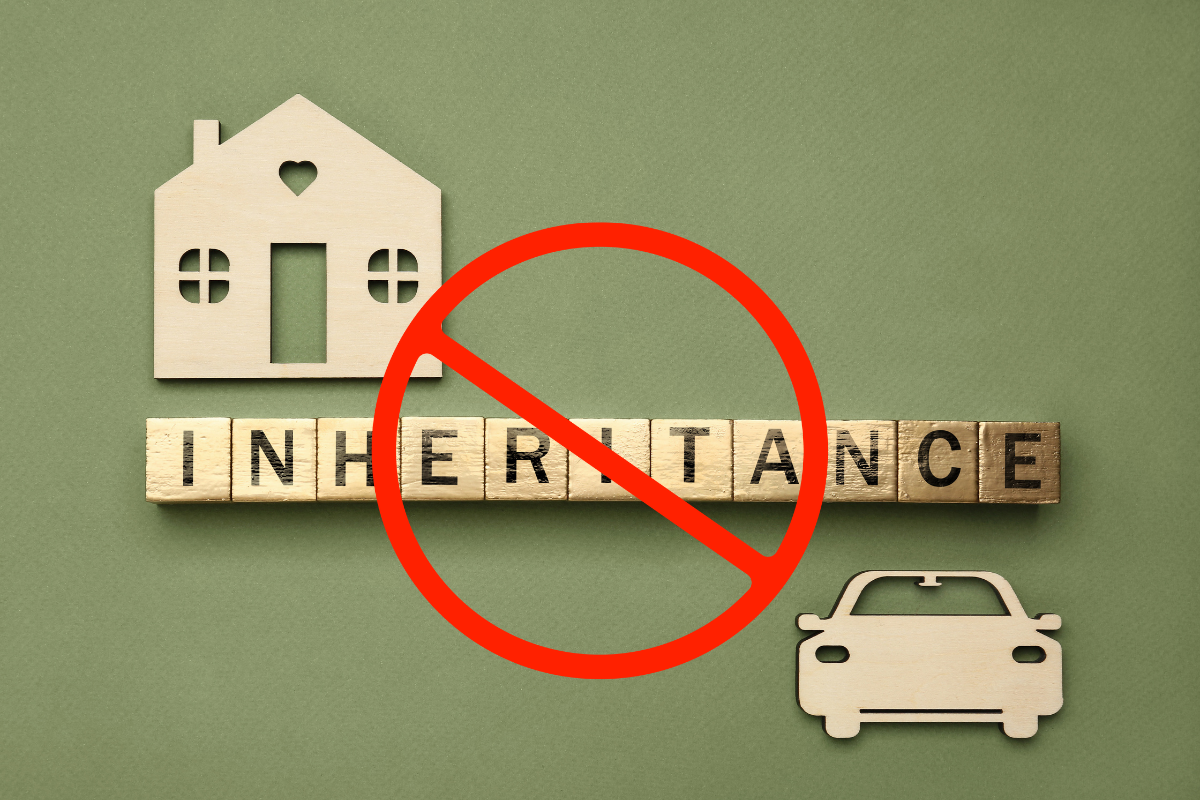Post Disclaimer: This blog reflects the author's personal experience with end-of-life matters and is provided in good faith for informational purposes only. While we aim to provide clear guidance on hard-to-find topics, this content is not legal advice and your use is at your own risk. Estate planning and end-of-life laws vary by location, so please consult your state's laws and seek guidance from a licensed attorney for your specific situation. We make no warranty about the accuracy or completeness of this information, which does not replace professional legal counsel. For more information, please see our full disclaimer.
Losing a loved one is never easy, and the legal aftermath can feel overwhelming.
For families managing estates, an inheritance disclaimer can offer clarity.
Simply put, it's a legal tool that allows an heir to refuse assets left to them.
This can be an important decision for personal, financial, or tax reasons, giving families flexibility in how an estate is distributed.
Understanding this option can help alleviate some of the stress during a challenging time.
For insights into related estate planning tools, check out Lady Bird Deeds and their role in simplifying property transfers.

What is an Inheritance Disclaimer?
An inheritance disclaimer is a significant yet often misunderstood tool in estate planning.
It allows heirs or beneficiaries to formally refuse assets or property left to them.
While it may seem counterintuitive to give up an inheritance, there are solid reasons why someone might consider this option.
Definition and Purpose
An inheritance disclaimer is a legal statement where a beneficiary declines all or part of an inheritance.
By doing this, they voluntarily step aside, as if the inheritance was never intended for them in the first place.
But why would anyone refuse what seems like a financial windfall?
Some common reasons include:
- Tax obligations: Accepting an inheritance may increase the recipient’s financial burden, particularly if it triggers estate taxes.
- Debt concerns: Assets might come with liabilities. For example, property could carry outstanding mortgages, and inheriting it might lead to ongoing expenses.
- Personal preferences: Sometimes, a beneficiary may feel someone else within the family deserves the assets more—not everything is about numbers.
Choosing to disclaim an inheritance can provide clarity during what is often a complex and emotional time and prevent additional complications down the road.
For an in-depth dive into estate planning benefits, you might explore Revocable Trust vs Irrevocable Trust.
Legal Framework
Disclaiming an inheritance isn’t as simple as verbally declining it—it requires following strict legal procedures to ensure validity.
Rules on how to disclaim inheritance vary by jurisdiction, but they typically share common requirements:
- Written Declaration: A disclaimer must be in writing, clearly stating the intent to refuse the inheritance. Oral declarations won’t hold up legally. Learn more on How to Disclaim an Inheritance.
- Irrevocability: Once you reject the assets, the decision is final. You can’t go back later and claim what you disclaimed.
- Timely Filing: Many jurisdictions mandate that the disclaimer be submitted within a specific timeframe, often nine months after the decedent’s passing. Delays can void the disclaimer.
- No Prior Ownership: The beneficiary must have made no effort to exercise control over the property, such as selling it or using it.
In the U.S., federal tax laws often require disclaimers to meet additional specifications, particularly for taxation benefits.
The legal jargon may seem intimidating, but understanding these rules can offer clarity when needed most.
For further legal details, explore Requirements for a Qualified Disclaimer.
Importantly, it’s wise to consult a legal professional when considering an inheritance disclaimer.
Each situation is unique, and navigating local laws effectively can make a huge difference for families aiming to keep things stress-free.

Reasons to Consider an Inheritance Disclaimer
When dealing with the aftermath of a loved one’s passing, financial and emotional decisions often collide.
One choice that may feel surprising at first is the option to disclaim an inheritance.
Choosing not to accept what’s left to you might appear counterintuitive, but there are valid reasons to do so.
Let’s explore some of the key factors that families should weigh.
Tax Implications
One major consideration is how accepting or disclaiming an inheritance affects taxes.
Depending on the size of the estate and local laws, inheritance taxes or estate taxes could significantly impact the beneficiary.
Disclaiming an inheritance may help reduce the estate's tax burdens.
For instance, it could allow assets to pass directly to someone in a lower tax bracket or minimize federal estate tax.
This is particularly useful with items that might increase in value, such as investments or real estate.
You can read more on why tax savings is a common reason to disclaim inheritance in this article on reasons to disclaim inheritance.
Remember, understanding specific tax rules in your jurisdiction is essential, and consulting a financial advisor or estate attorney can help simplify the process.
Family Dynamics
Relationships within a family can sometimes add complexity to inheritance decisions.
By disinheriting yourself, you may help resolve tensions or clarify the distribution of assets.
For example, if you genuinely believe that another family member might benefit more from the inheritance financially or emotionally, disclaiming can reflect your intentions.
On a less altruistic note, some heirs might choose to disclaim to avoid responsibility for shared assets, such as a property requiring joint upkeep.
The right decision often depends on the situation.
Considering these relational nuances can be crucial, and families may benefit from a legal or mediation expert to ensure that choices don’t unintentionally spark long-term discord.
Personal Financial Goals
Your own financial situation can also greatly influence the decision to disclaim an inheritance.
Sometimes, accepting might create complications rather than solutions.
For example:
- Receiving a large sum might push you into a higher income bracket, increasing tax obligations overall.
- You might already own property and want to avoid additional management costs or risks associated with inherited holdings.
- Declaring bankruptcy or actively managing debts? Accepting inheritance could disqualify you from debt relief functions like Chapter 7 proceedings and complicate financial planning.
Disclaiming can also align with long-term goals, like ensuring assets pass directly to the next generation to avoid probate fees or estate taxes for everyone involved.
For further insights on handling estate matters, you may find the guidelines on managing death certificates during estate planning beneficial.
Inheritance disclaimers remain a deeply personal yet strategic decision.
There are benefits to making this choice thoughtfully and with the right support, especially in uniquely challenging family or financial circumstances.

Process of Disclaiming an Inheritance
Deciding to disclaim an inheritance is not an everyday decision.
However, for some, it's a critical step in managing personal and financial situations.
While the process might seem daunting, it follows a straightforward path when done correctly.
Let’s break it down.
Notify the Executor
The first step in disclaiming an inheritance is informing the estate's executor about your decision.
This individual plays a pivotal role in the administration of the estate and is responsible for ensuring that your disclaimer is properly processed.
A clear and direct communication with the executor helps prevent misunderstandings and ensures that your intentions align with legal requirements.
Why is this step so important? Timing matters.
Many jurisdictions have strict deadlines—often nine months from the decedent's passing—within which a disclaimer must be submitted.
Delaying this notification could risk losing the opportunity to disclaim altogether.
To learn more about timing and executor roles, you might find this reference about reasons to disclaim an inheritance helpful.
Filing the Disclaimer
Once you've decided to proceed and informed the executor, it’s time to tackle the paperwork.
Remember, disclaiming is not as simple as saying, “No thanks.”
It requires an official and written statement—a document often referred to as a “Disclaimer.”
The written disclaimer must include:
- Your clear refusal of the inheritance, detailing the assets or portion being disclaimed.
- A signature verifying your intent.
- Compliance with local legal formats, as each state or jurisdiction may have unique requirements.
A critical point to consider is that the disclaimer must be delivered to the executor within the required time frame.
To understand the legal document structure, resources like this guide on disclaiming inheritance steps can provide more insights.
Above all, the disclaimer must maintain its irrevocability.
Once filed and accepted, you can’t change your mind or reclaim the disclaimed assets.
Legal Advice
While it can be tempting to save money by filing a disclaimer on your own, seeking legal counsel is strongly recommended.
Why? Even small errors can void your disclaimer and bring complicated repercussions.
An attorney ensures that every step you take aligns with federal, state, and local laws.
A lawyer can:
- Draft the disclaimer to meet legal standards.
- Clarify tax implications associated with your decision.
- Explain how your actions might affect other heirs in the estate.
Additionally, some disclaimers might interact with federal tax laws—particularly if the estate meets certain thresholds.
If you're unsure about any part of the process, consider reading this article on how to disclaim inheritance for clarity.
Disclaiming an inheritance is a deeply personal choice, yet it's governed by intricate and often rigid legal systems.
Equipped with the right information and professional advice, you can navigate this process effectively, ensuring that your decision brings financial and emotional clarity without unintended pitfalls.

Potential Consequences of an Inheritance Disclaimer
Disclaiming an inheritance can be a thoughtful choice, but it’s not without its consequences.
By giving up your claim to inherited assets, you forfeit certain benefits and potentially set into motion outcomes that impact others.
Here’s a look at the key consequences of choosing to disclaim.
Loss of Assets
One of the most direct results of an inheritance disclaimer is the permanent loss of access to any disclaimed assets.
Once you legally disclaim, the inheritance bypasses you entirely, as though you were never eligible to receive it.
- No future control: Disclaiming an inheritance means you lose the ability to control, manage, or direct how the disclaimed assets are used. For example, if you disclaim shares or property, you can’t later influence decisions about their sale or use.
- Irrevocability: A disclaimer is final. This decision can’t be reversed later, even if your financial or personal circumstances change.
- Next beneficiaries: Since these assets pass to contingent beneficiaries, it will be entirely up to those recipients to manage or use them—regardless of your original intentions.
By relinquishing your rights, you also bypass any future revenue streams or appreciation from the assets.
For example, family real estate or investments might generate income or increase in value over time.
Consider exploring resources, such as this guide on disclaiming inheritance, to understand the profound effects of disclaiming.
Impact on Will and Trust Provisions
An inheritance disclaimer doesn’t exist in a vacuum—it significantly alters how a decedent’s estate is distributed.
The process dictates that disclaimed assets “fall through” to other beneficiaries as outlined in the original will or trust, effectively bypassing your line in the inheritance chain.
- Respective laws: If other beneficiaries are named, assets will transfer to them directly. But if no contingent beneficiaries are listed, state intestacy laws may come into play to determine asset distribution.
- An adjusted estate plan: Disclaiming can unintentionally distort the decedent’s intended asset distribution. For families, this might create confusion or even disputes if some members feel that the new distribution isn’t equitable.
- Trust complexities: In the case of trust provisions, disclaimers could trigger unique administrative issues. For instance, assets set to be managed within a trust may need redistributions or additional legal review.
It’s also worth noting that disclaiming strategically can sometimes benefit the overall estate.
Assets might pass to individuals in lower tax brackets or help avoid probate issues.
If you're interested in a broader understanding of compliance with disclaiming rules, consider reading Declining an Inheritance for more insight.
Understanding the "who" and "how" of re-allocation is crucial.
Missteps in this area could potentially lead to prolonged legal challenges among family members or beneficiaries.
Every inheritance disclaimer alters the estate distribution path, making professional guidance essential to avoid potential snags.
A thoughtful, well-informed decision about an inheritance disclaimer can bring clarity, but the impacts are significant.
For more perspectives on financial decisions concerning estates, you can explore related topics like Lady Bird Deeds, which can also influence how assets are assigned.
FAQs: What is an inheritance disclaimer?
Can someone disclaim only part of an inheritance while accepting other parts? For example, could I disclaim a property but keep inherited stocks?
Yes, partial disclaimers are possible under specific conditions.
You can disclaim certain assets while accepting others, as long as you clearly identify the specific assets being disclaimed in your written statement.
Each disclaimed asset must be handled separately and meet all legal requirements, including the nine-month deadline.
However, you cannot disclaim only a portion of a single indivisible asset - you must either accept or disclaim it entirely.
What happens if the next beneficiary in line also decides to disclaim the inheritance? Is there a limit to how many times assets can be "passed down" through disclaimers?
There is no legal limit to the number of successive disclaimers that can occur.
Each subsequent beneficiary has the same right to disclaim as the original beneficiary, creating what's sometimes called a "disclaimer chain."
The assets will continue to flow to the next eligible beneficiary according to the will or trust until someone accepts them.
If no eligible beneficiaries remain willing to accept, the assets typically pass according to state intestacy laws.
If I've already verbally told family members that I plan to accept an inheritance, can I still legally disclaim it later?
Merely discussing your intentions about an inheritance doesn't necessarily prevent you from disclaiming it later.
However, taking any actions that could be interpreted as accepting or exercising control over the inherited assets - such as using them, managing them, or making decisions about them - can invalidate your ability to disclaim.
The key is that you must not have accepted any benefits from the specific assets you wish to disclaim, regardless of what you may have said about your plans.

Wrap-up: What is an inheritance disclaimer?
Inheritance disclaimers provide a unique opportunity for individuals and families navigating the complexities of estate planning.
While choosing not to accept an inheritance might seem unusual, it can be a thoughtful, strategic decision in certain situations.
Whether it's to alleviate tax burdens, address family dynamics, or align with personal financial goals, understanding the full scope of disclaimers helps families make informed choices.
Check out the Up & Doing glossary page for an alphabetical listing of key terms related to estate administration, funeral planning, and other end-of-life topics.




